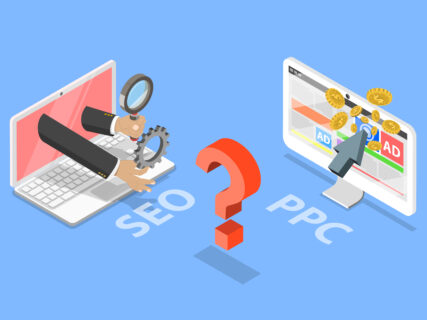
10 mins
OpenSEO vs PPC: The pros, cons, and how they can complement each other in a search campaign
7 mins
18th December 2023

Your website holds the prime position as your brand’s online storefront, so it makes sense to give it a do over from time to time. Just like you need to periodically re-decorate your brick-and-mortar store or even move to a shiny new shop altogether, sometimes it’s necessary to fix up your company’s website.
One of the most significant ways to revamp it is through a migration.
Generally speaking, a website migration is where a fundamental change is made to a site’s URL structure, and can encompass adjustments to a site’s navigation and design, a move to a new CMS, server or domain name entirely.
There are many reasons you may want to undergo a website migration, including to improve the site’s design, speed up load times, update the backend software, or enhance your website’s security.
However, while the potential advantages of a website migration are manifold, so are the risks, which include everything from harming your existing keyword visibility to losing parts of your website entirely.
But fear not. With a little pre-planning, you can avoid these perils — trust us. This is exactly why we’ve created this website migration checklist to get you through the process unscathed.
Firstly though, what are the main types of website migration, and how might these affect your site?
As the saying goes: fail to prepare — prepare to fail. Before you can even start creating your website migration checklist, it’s important to work out key details like the campaign’s objectives and your migration team.
What is it you’re looking to achieve from your website migration? Is it a simple design upgrade, or are you looking to change your site’s structure entirely? Whatever it is, define your objectives from the get-go to give you and your team clarity.
Next, decide when to carry out the migration and consider how long it will take. It’s important to have a deadline to ensure that the project doesn’t drag on indefinitely — however, do give yourself enough time here. Slow and steady wins the race, after all.
It’s also a good idea to, if possible, carry out the migration during your business’s off season in order to minimise disruption.
Finally, decide who will comprise your migration team, whether it’s internal or external team members, or a mixture of both. You’ll typically need either some or all of the following specialists during a website migration:
This stage involves a meticulous review of the website’s current design and, if you’re redesigning the site, the new design wireframes and prototypes.
Some of the aspects that are commonly changed during this stage include:
Once designs have been confirmed, any changes can be implemented on the staging website. This functions as a clone of your live website, giving you a secure environment to make adjustments.
During this stage, the web developers will not only address the issues they see pre-migration, but work on the staging website to test things like:
It’s important to note here that the staging website should not be indexable, or you run the risk of creating duplicate content with the live website — a big no-no in the world of SEO. This can be prevented by requiring password authentication for access, and instructing crawlers not to index the website in the robots.txt file.
Once the designs are updated on the staging website, it’s time to add any new content, features, and imagery. This might include:
It’s crunch time. At this point, the migration deadline will be rapidly approaching. All the designs and audits for the staging website should have been completed, while the URL mapping and redirects need to have been prepared. All of this ensures that, when the day comes, you can transition to the new website as smoothly as possible.
It’s highly recommended to run a pre-migration audit during this stage, which can include everything from creating a content inventory to finalising a backup strategy should something go wrong on the day.
The big day has finally arrived! Well done for making it this far. Some of the typical steps involved during this phase include:
Finally, be sure to conduct a post-migration audit to ensure everything is running smoothly, and monitor the indexation of the new pages going forward, as well as any ranking volatilities.
Over time, you’ll want to look for issues like:
A site migration might sound incredibly daunting, but by using our website migration checklist, you increase the chances of a bump-free process. However, even if you follow the checklist down to a tee, it has barely scratched the surface of the ins and outs of a typical website migration.
Combined with the potential for things to go wrong and the consequences this may bring, it’s little wonder that businesses tend to seek out SEO specialists to help oversee the process, which is where Go Up can help you too.
We have worked with various brands — including the likes of Banham and Petainer — on all kinds of website migrations and at various stages of the process, from right at the beginning (which is our preference, by the way!) to the not-quite-as-ideal post-migration “everything’s gone wrong” phase. The results of these migrations speak for themselves, which is exactly why you can trust us to handle the process.
Still not convinced? You can learn more about our website migration service and success stories here, including a deep dive on our process. Feel free to get in touch with our team if you have any more questions too, or want to make an enquiry. We hope to hear from you soon!